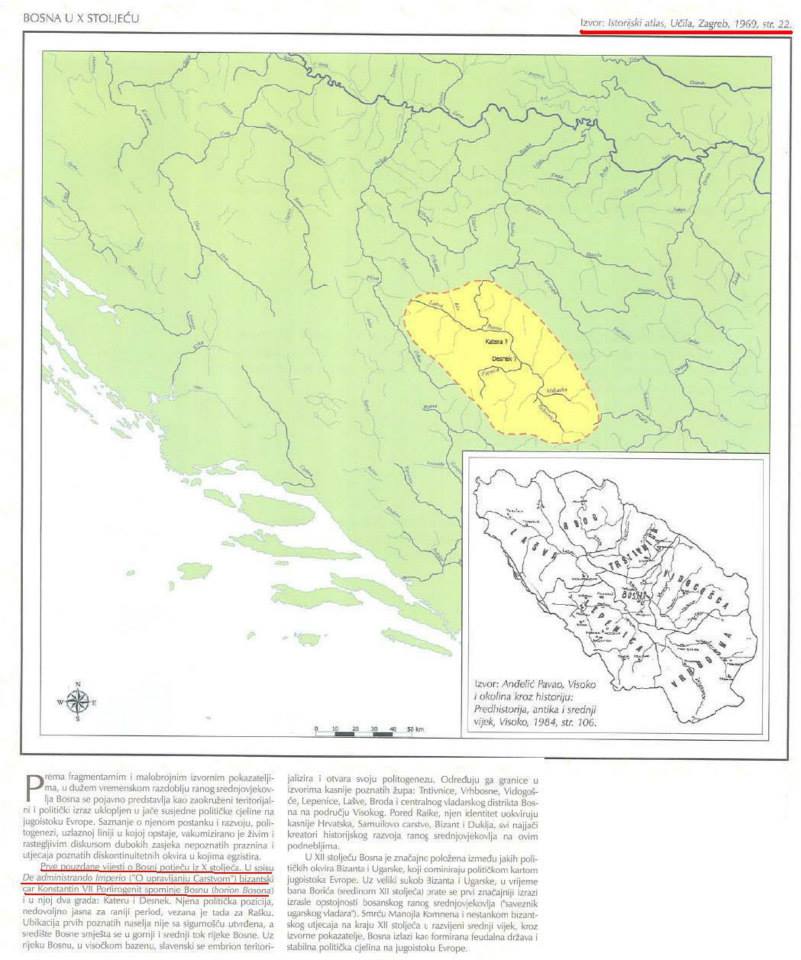- When we talk about the oldest mention of Serbs in Bosnia (without Herzegovina, contemporary north Bosnia and Bosnian Krajina, territories which will over long historical period gradually fuse with Bosnia) we refer to the oldest piece of land called like the namesake river of Bosna. This first Bosnia spanned, roughly, the territory between modern-day cities of Sarajevo and Zenica with center being in the city of Visoko and its surroundings. The following map shows initial Bosnia marked in yellow referenced to the present day territory of the Bosnia and Herzegovina:
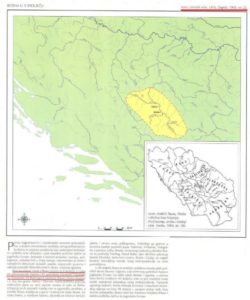
Medieval land of Bosnia developed within the medieval Serbia and is mentioned for the first time in mid-tenth century as its integral part. It was the time of duke Časlav reign whose land gathered majority of the Serbian ethnic space from that period. It was first mention of Serbia as land of the Serbs in the Balkans, with Bosnia described as one of its lesser regions, shown on this map: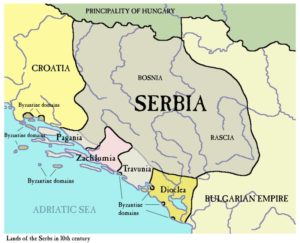
First information regarding duke Časlav Serbia and Bosnia as its constituent part can be found in the work of the byzantine emperor Constantine VII Porphyrogenitus (945-959) called “On the Governance of Empire”. In the chapter named “On Serbs and land they now inhabit”, the scholar-emperor lists areas with certain elements of statehood and those are Zachlumia, Travunia with Konavle, Pagania or Neretva area with the main and the largest of them being the “baptized Serbia”. In this “baptized Serbia” work of the Constantine VII mentions area called “little land Bosnia” using diminutive form to clarify the relation between sizes of Bosnia, a constituent part, and Serbia, the whole state. As the chapter name implies, Serbs in the mid-tenth century inhabit the “baptized Serbia”. Given that Bosnia is integral part of Serbia at that period, Serbs therefore inhabit Bosnia as well.
Next mention of Serbs comes from the year 1150 when byzantine writer John Kinnamos, writing on the war of Serbs and Hungarians against Byzantium, describes Bosnia as land of the Serbs. In his works, Kinnamos refers to Serbs as Dalmats due to the fact Serbs inhabited territory of the old roman province of Dalmatia. In the part of the text regarding Bosnia, Kinnamos describes the bosnian ban Borić as “exarch of the Dalmatian land of Bosnia”. Given that Kinnamos names Serbs as Dalmats, its logical to presume that Borić is ban of the Serbian(Dalmat) land of Bosnia. Kinnamos is more precise when he says, in another part of his work, that river Drina separates “Bosnia from the rest of Serbia”, which indicates that byzantine historian sees Bosnia as part of Serbia, as part of a greater political entity in the Balkans, inhabited by Serbs.
During XII and XIII centuries, in several charters issued by the Pope, Bosnia is referred to as part of the Serbian state. In Latin it follows as such “regnum Seruilie quod est Bosna”, which translates as “that part of Serbia, called Bosnia”. We should bear in mind that in this period, Bosnia was, in political sense, semi-autonomous, recognized authority of the Hungarian kings and was not part of that period Serbia. It could be assumed Rome had previous knowledge that Serbs were inhabitants of Bosnia and that it used to be part of a greater, earlier Serbian state.
In the first half of the XIII century, when Bosnia was ruled by ban Matija Ninoslav, there are at least three references from his diplomatic correspondence and charters issued to Dubrovnik from 1234 to 1249 where he refers to his subjects as Serb and inhabitants of Bosnia. Translated to contemporary English it follows as written:”If Serb sues Vlachos, it should be brought before the duke, if Vlachos sues a Serb, it should be brought before the ban.” Under term Vlachos charters actually refers to traders from Dubrovnik while Serbs are subjects of the ban and people of Bosnia, which can be seen from the fact that, according to the documents cited above, ban Ninoslav, in case where Serb harms Vlachos(resident of Dubrovnik), pronounces judgment over Serb if found guilty given that it is his subject and resident of his land, Bosnia.
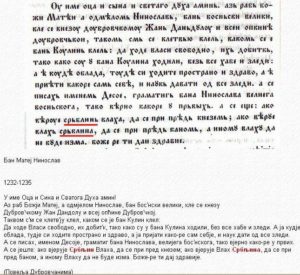
These were the oldest remembered accounts on Serbs in early Bosnia, which doesn’t imply Serbs didn’t inhabit land of Bosnia prior to these records. With time, Bosnia itself will expand and it will envelop other lesser territories such as Usora, Soli, Podrinje, Donji Kraji, Zachlumia and others. These lesser areas were inhabited by Serbs as well, given that all of them were part of Serbia described by Constantine VII or those lands inhabited by Serbian population but outside of early Serbia, Zachlumia for example. Throughout historical development of Bosnia, Serbs have been mentioned on more occasions than those few we outlined above but we restricted ourselves on the early Bosnia and earliest written records mentioning Serbs living in it. In the end it should be said that the oldest written record with information on Serbian people in the Balkans dates from 822 and was the work of the Frankish writer Einhard. His account describes Serbs living further west than the original territory of Bosnia, on the shores of river Una, in lands which will become part of Bosnia or Bosnian Krajina only after arrival of Ottoman Empire and occupation that will follow.
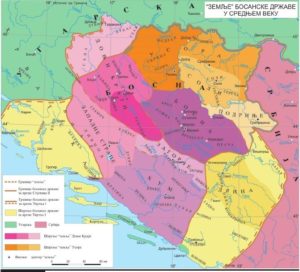
Author: Boris Radaković
Translate: Ljubisa Malenica
Донирајте или се рекламирајте на „Срби у Босни и Херцеговини кроз епохе и судбине“ једином сајту на свијету који описује живот нашег народа на просторима БиХ од насељавања Срба у 7. вијеку до одбрамбено-отаџбинског рата а кроз призме политичке, културне и духовне историје.
